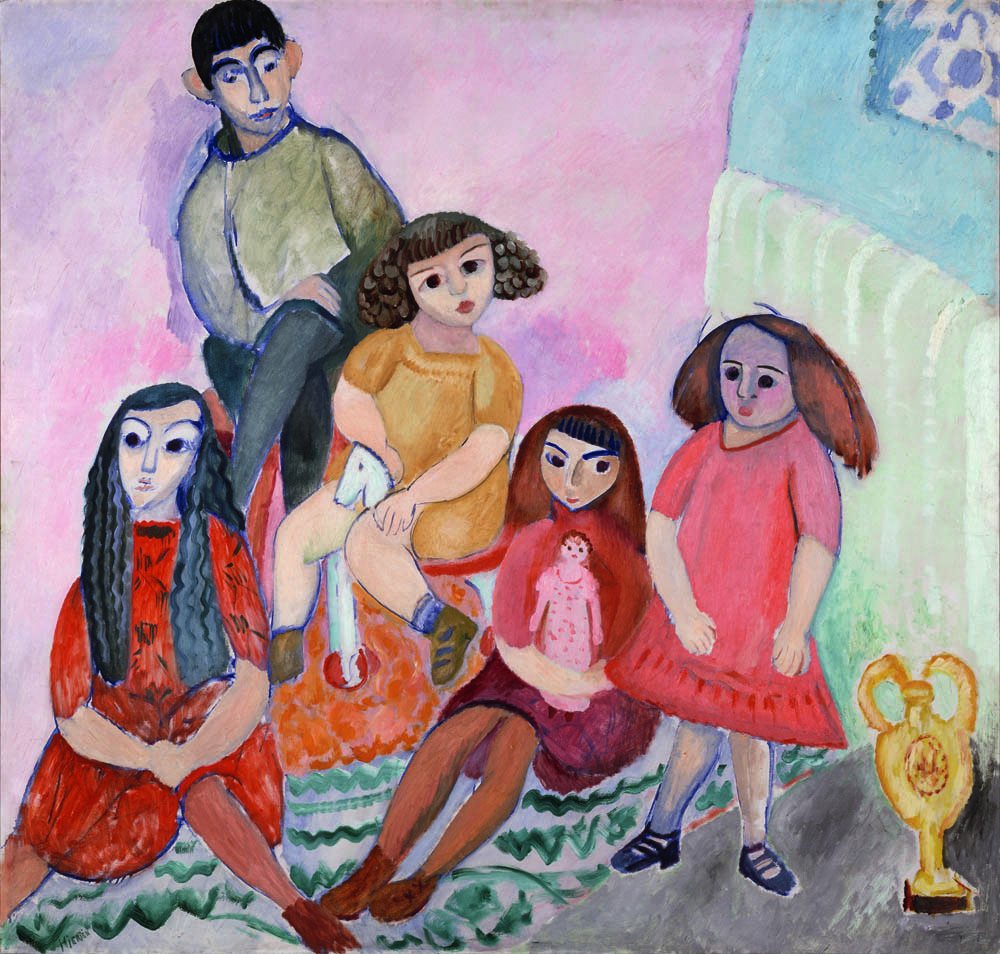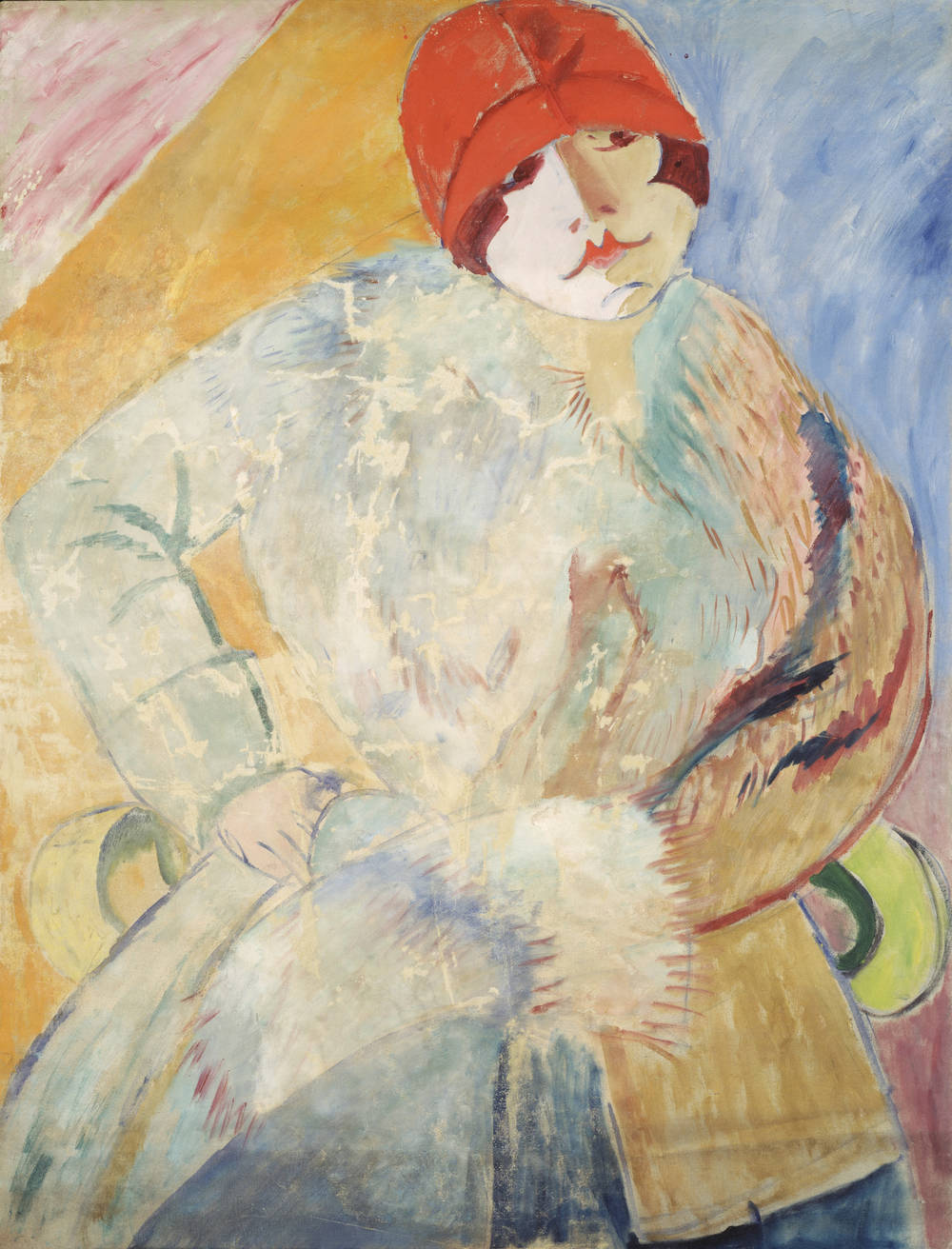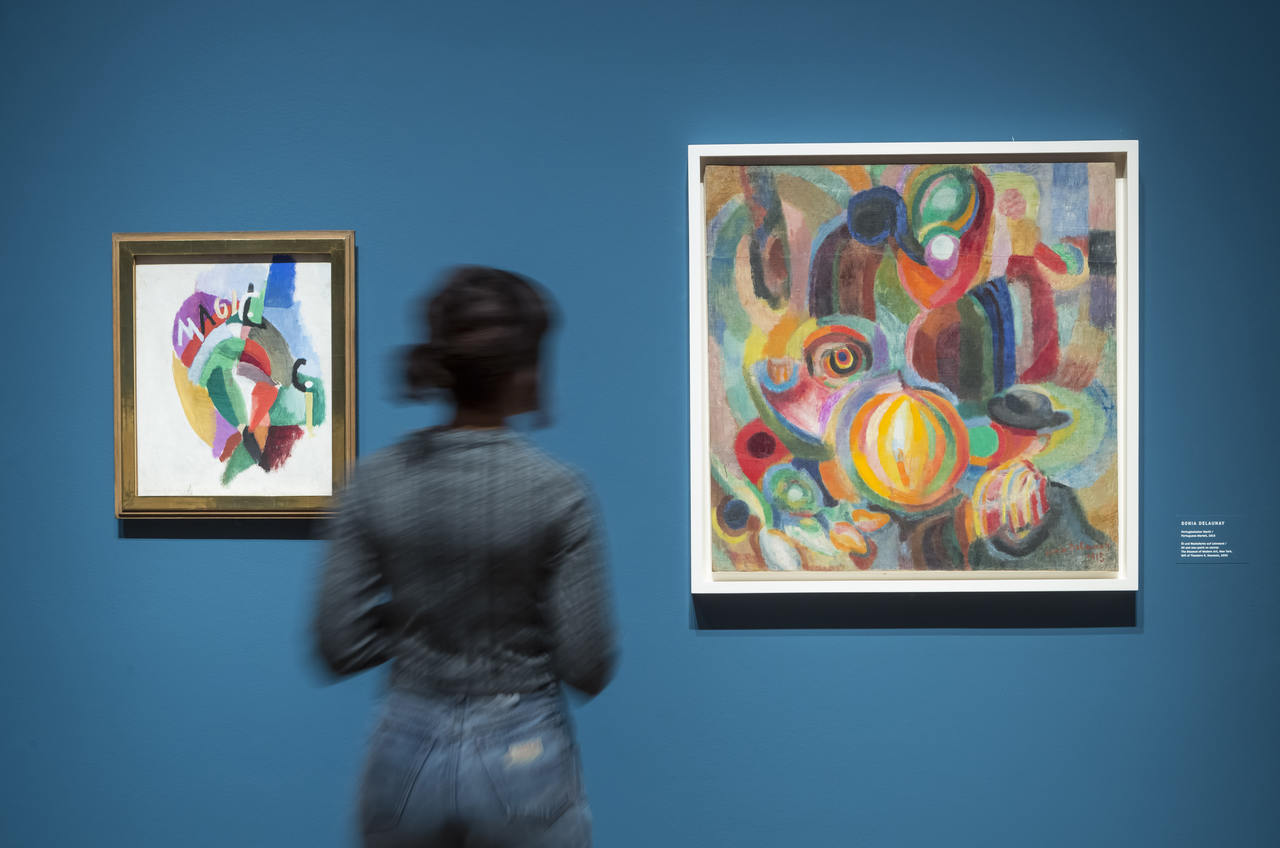She alternates seemingly casually between the role of mother and that of artist and is considered the pioneer of Swedish Expressionism: STORM artist Sigrid Hjertén.
The name is simply Ateljéinteriör or Studio Interior. It is one of the most famous paintings by Sigrid Hjertén, and anyone looking at it will find it hard to believe the image is almost a century old. The Swedish artist depicts herself here twice; once in the middle of the studio and a second time with a companion, like spectators observing an interesting spectacle. Pastel-colored light comes in through the enormous windows, the walls are turquoise; indeed, everything is resplendent in tender colors. On the sofa sits a woman surrounded by two men. On closer inspection it turns out to be the artist herself, while her husband Isaac Grünwald is one of the two men. On one wall hangs a portrait of a woman, on the other side of the sofa there is a sculpture, in front of the sofa a tea set.
While the colors are unusual and their presentation is very modern what really makes the interior so radical is how Sigrid Hjertén illustrates her own role in life – indeed, two roles are united in a single picture, whereby the fact that the two do not line up is manifest. As an observer of events the artist oozes self confidence: she sits there, her legs casually crossed in her exquisite black dress with the feather trimming and tall boots, and seems visibly amused. Her companion is not her husband, a fact that is also emphasized in the painting. Here, she undoubtedly is at the real center of events, she is the queen, who turns her back on her son – with his pale turquoise face the same color as the walls and ceiling, the boy symbolically merges into the background.
The ambivalence of her own role
Regardless of how exactly you define the term, Sigrid Hjertén was very definitely not a bad mother. The Swedish artist repeatedly portrayed Ivàn, likewise her husband and other people close to her, and often spent a lot of time with her son in the studio. But what is impressive and radically modern is precisely the ambivalence this picture articulates: It is not without a touch of self-irony that Hjertén defines herself in a single painting both as an artist and a mother, with a husband and with a companion, reputed to be fellow painter Nils von Dardel. She quite naturally claims for herself this dual role or rather multi-role, which implies that a woman must not and does not wish to be primarily a mother or wife all the time.

Sigrid Hjertén must have been aware at an early age that she would not be happy with the sort of career (women) normally pursued in the early 20th century. She was born in 1885 in Sundvall, Sweden, to parents who were wealthy business people. Hjertén was not content with training to become a drawing teacher; she decided to enroll to study textile design in Great Britain. Though these plans came to nothing, it did lead to her embarking on a career as an artist: In her mid-twenties she met her later husband Isaac Grünwald, who supported her from the start and persuaded the young woman from Stockholm to follow him to Paris. At the Académie Matisse she was to become the much-respected student of the artist himself, who initially had a strong influence on her style.
She paved the way for Modernism
Apart from extraordinary talent Sigrid Hjertén’s work is also characterized by astounding productivity, which is all the more surprising if one considers the various roles she had to juggle and the various claims on her, as illustrated in her famous painting. In the course of 30 years of painting she created hundreds of pictures and took part in over 100 exhibitions, including several by STURM gallery owner Walden.
One monograph on Sigrid Hjertén is entitled the “Pioneer of Swedish Expressionism”. And indeed Hjertén’s influence on Swedish Modernism cannot be emphasized enough; yet she also remained open for a wide variety of currents and ideas of fellow artists, first in Paris and later in Stockholm, which is reflected in her broad range of styles. Alongside what is sometimes a decidedly self-ironic choice of themes and the expressive figures her paintings are also characterized by an often extravagant use of color.
Diagnosed with schizophrenia in Stockholm
Anyone who examines Sigrid Hjertén’s work from a chronological point of view cannot help but notice an increasing change in her paintings from the late 1920s onwards: the colors become gloomier and the subject matter more suggestive of loneliness. Indeed, many pictures appear truly bristling with tension. Hjertén’s mental illness began around this time, expressing itself initially in minor psychosomatic ailments, and although her condition improved now and then the illness could never be completely conquered. Another possible explanation for this inner tension that deserves consideration is the conflict between people’s expectations of her and her life as she actually lived it, bearing in mind that almost a hundred years ago a woman’s life must have been considerably more stressful that it is today.

At any rate, Sigrid Hjertén spoke of feeling increasingly lonely: Isaac Grünwald, who had various lovers during their marriage, moved back to Sweden, while she remained in Paris initially. Later she was to follow him and once back in Stockholm she was diagnosed as having schizophrenia. After a course of treatment the artist was well enough to resume painting. But in the late 1930s her condition worsened so much that she stopped painting altogether. Sigrid Hjertén died ten years later following complications after a botched lobotomy, then considered a means of curing serious mental illness.

Sonia Delaunay: The liberation of color
Canvases, objects and clothing were all mediums for her clashing color compositions, which to this day have lost nothing of their Modernist feel. A...

„Your body is a battleground“
Women in art: For a long time women in art were only seen on the canvas. The role of the woman as artist and creative mind has been slowly but surely...
 Sigrid Hjertén, Ateljéinteriör, 1916
Sigrid Hjertén, Ateljéinteriör, 1916 Sigrid Hjertén - Portrait of the Artist Isaac Grünewald, 1918
Sigrid Hjertén - Portrait of the Artist Isaac Grünewald, 1918